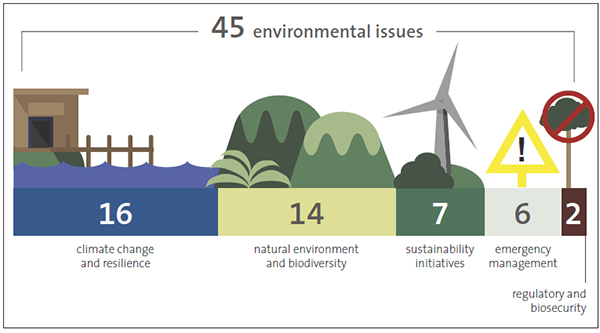Part 4: Climate change matters disclosed in the 2021-31 consultation documents
4.1
In this Part, we cover the climate change matters disclosed in the 2021-31 consultation documents, including:
- why we focused on climate change;
- how climate change was discussed in the consultation documents; and
- the types of environmental issues, including climate change, councils consulted their communities on.
Why we focused on climate change
4.2
New Zealand is expected to experience the effects of climate change. These include higher temperatures, a change in rainfall patterns, rising sea levels, and more frequent and intense extreme weather events.
4.3
Adapting to and mitigating the impacts of climate change are significant challenges for councils. A 2019 report by Local Government New Zealand estimated that local government's infrastructure at risk was about $8 billion.12 Given councils' role in environmental planning and regulation, much of the responsibility for adaptation falls to local government.
4.4
When we reported on the results of our audits of the 2018-28 long-term plans, we observed that:
… councils need to be transparent with their communities about their current understanding of risk and what this means for future decision-making.
For the 2021-31 LTPs, we consider that there is a need for a comprehensive discussion of resilience and climate change issues with the community. This discussion needs to include financial and non-financial effects.13
4.5
As a result, climate change assumptions and disclosures were a focus for our auditors when auditing the 2021-31 long-term plans and associated consultation documents. We comment on what we found in our review of consultation documents.
All consultation documents discussed climate change
4.6
All councils used climate change assumptions to inform their underlying information. All consultation documents also discussed climate change. These disclosures generally covered how climate change was expected to affect the council and its community, and what the council planned to do in response.
4.7
We commend the councils on doing more to discuss climate change with their communities.
4.8
In our view, councils' planned responses to climate change, as outlined in consultation documents, were variable. This is expected because councils are at different stages of assessing the impact of climate change and their role in climate change adaptation and mitigation. Some councils are still in an investigation phase. Other councils have put projects in place or are consulting on potential projects.
4.9
For example, after Bay of Plenty Regional Council declared a climate change emergency in June 2019, it set out its "climate change statement" in its consultation document. This statement outlined the Council's vision and objectives, the "transformational shifts" required in the region, and what it planned to do as a result. The Council saw the statement as a framework to inform and guide how it could work in partnership with Māori and support conversations about regional climate change challenges.
4.10
For some councils, preparing for climate change was at the centre of their planning. For example, Waipā District Council's consultation document set out four community outcomes and five external strategic priorities, of which one was "preparing for climate change". The Council's consultation document outlined that all its strategies, plans, policies, activities, and work programmes will be shaped to successfully deliver on these outcomes and strategic priorities.
4.11
Central Otago District Council integrated climate change throughout its consultation document, which we considered to be particularly effective. Although the Council did not consult on specific climate change matters, it highlighted the potential impacts of climate change (such as more frequent extreme weather events) on its infrastructure. The Council consulted on projects that would also achieve emissions reductions, such as installing energy efficient systems at its facilities and encouraging walking and cycling.
4.12
Our report on our audits of the 2021-31 long-term plans will report more fully on councils' planned responses to climate change.
The environmental and climate change issues that councils consulted on
4.13
Figure 9 summarises the types of environmental issues councils consulted their communities on. Although we can view these as separate issues, in many ways climate change and resilience intersect with environmental issues as well as with broader issues such as health and community well-being. They also impact on socioeconomic and cultural factors. This demonstrates the significance of environmental issues as a consultation matter.
4.14
In total, 29 councils consulted on 45 separate environmental issues. The largest types were climate change and resilience (16 issues) and the natural environment and biodiversity (14 issues).
Figure 9
The main types of environmental issues consulted on in the 2021-31 consultation documents

Source: Our analysis of the 2021-31 consultation documents.
Examples of climate change and resilience issues consulted on
4.15
We identified 16 consultation issues where councils are taking action to respond to climate change and working to make their communities more resilient. Consultation issues included the size and extent of the council response, the timing of projects, and asking the community how strong the response to a changing climate should be.
4.16
We recognise that the impacts of climate change are far broader and can be reflected through other interrelated issues, such as the other 29 environmental issues and the 47 issues on funding.
4.17
Councils are also responsible for planning for and providing infrastructure, managing land use, and avoiding or reducing risks from natural hazard events such as floods, storms, and sea-level rise. Climate change is changing the severity and frequency of these events. Figure 10 lists some examples of the consultation issues relating to climate change.
Figure 10
Some consultation issues relating to climate change
| Consultation issue | What are councils doing? |
|---|---|
| Strategies and planning | Councils are at different stages in their climate change response, and some wanted community feedback on proposals to prioritise planning and strategic development work. Whanganui District Council consulted on the development and implementation of its coastal plan to assess options for coastal management, which will inform the development of budgets for implementation of solutions to erosion, restoration to wetlands, and weed control. |
| Level of investment | Some councils were seeking community feedback about the level of investment they were proposing to make into climate change responses. Timaru District Council asked its community how much it should invest, with a preferred option to make some progress, including the development of a climate change strategy and to increase engagement with communities and businesses to lead and support climate change resilience efforts. Although the Bay of Plenty Regional Council saw its biggest impact as influencing a greater use of public transport, it also asked its community for feedback on which climate change projects it should fund. These projects included facilitating community conversations about adaptation approaches and facilitating a regional approach to climate change risk assessment and adaptation plans. |
| Flood protection works | Hawke's Bay Regional Council consulted on a proposal to focus on water conservation and water use efficiency, as well as improving flood protection systems by removing gravel and dredging some of the region's rivers. Similarly, Gisborne District Council consulted on its flood plan proposal to build stop banks. This will ensure a higher level of protection from floods by 2030. |
| Transportation network | The disruption to the transportation network from sea-level rise, flooding, or landslides could lead to increased maintenance costs. Wellington City Council highlighted that one of the most significant actions as part of the Te Atakura First to Zero consultation option to reduce the city's emission will be shifting transport modes from fossil fuels to electric cars, public transport, cycling, and walking. The Greater Wellington Regional Council consulted on an option to electrify the bus and rail network to reduce public transportation emissions through decarbonisation so that it can achieve carbon neutrality by 2030. |
Examples of other environmental issues consulted on
 Natural environment and biodiversity
Natural environment and biodiversity
4.18
Hamilton City Council has noted that a priority for its community was shaping a green city. Because of this, the Council consulted on gully restoration. This included investment to maintain the city's main gully systems, improve access through paths and boardwalks, establishing a biodiversity and monitoring programme, and supporting the community to care for and restore nature.
4.19
Napier City Council and Hawke's Bay Regional Council both consulted on a project in partnership with mana whenua to create a new regional park (Ahuriri Park) to promote better environmental and recreational outcomes. The Ahuriri Estuary (Te Whanganui-a-Orotū) receives 75% of Napier's stormwater. Napier City Council and Hawke's Bay Regional Council proposed to invest in the development of the park. This could benefit the area in many different ways, such as stormwater quality improvements, connections from the wetland area to the estuary, increased biodiversity and indigenous planting, and habitat restoration and protection.
 Biodiversity and pest management
Biodiversity and pest management
4.20
New Zealand's biodiversity is threatened by habitat loss and damage. Moreover, climate change will mean changes in the type and distribution of pest species. Protecting biodiversity was a consultation issue for the Waikato and Northland Regional Councils, which would mean investing in biodiversity management and restoration efforts to support the community's economic, environmental, and cultural well-being.
4.21
Gisborne District Council consulted on improving biodiversity and funding several projects, including indigenous planting activities, dune and wildlife protection, and the transformation of the Waingake bush.
 Sustainability initiatives
Sustainability initiatives
4.22
Upper Hutt City Council explained that it will be incorporating sustainability initiatives into its operations as part of its Sustainability Strategy. One of the consultation issues proposed was to implement a sustainability stimulus grant to help reduce the city's emissions profile.
4.23
Waikato Regional Council consulted on developing a sustainable home scheme where the Council would borrow money to help households install improvements like water tanks, insulation, double glazing, heating, ventilation, solar power, and septic tank upgrades. This would support well-being by helping homeowners make improvements without having to pay the full cost upfront. Creating healthy homes and sustainable forms of energy generation, and reducing air pollution, would also result in health benefits.
 Emergency management
Emergency management
4.24
Northland Regional Council consulted on constructing a new emergency co-ordination centre because there is no dedicated centre in Northland. In consulting on this issue, the Council acknowledged that recent emergency events in New Zealand have highlighted the need for purpose-built, multi-agency co-ordination centres.
12: Local Government New Zealand (2019), Vulnerable: The quantum of local government infrastructure exposed to sea level rise, page 2.
13: Office of the Auditor-General (2019), Matters arising from our audits of the 2018-28 long-term plan, page 45.

